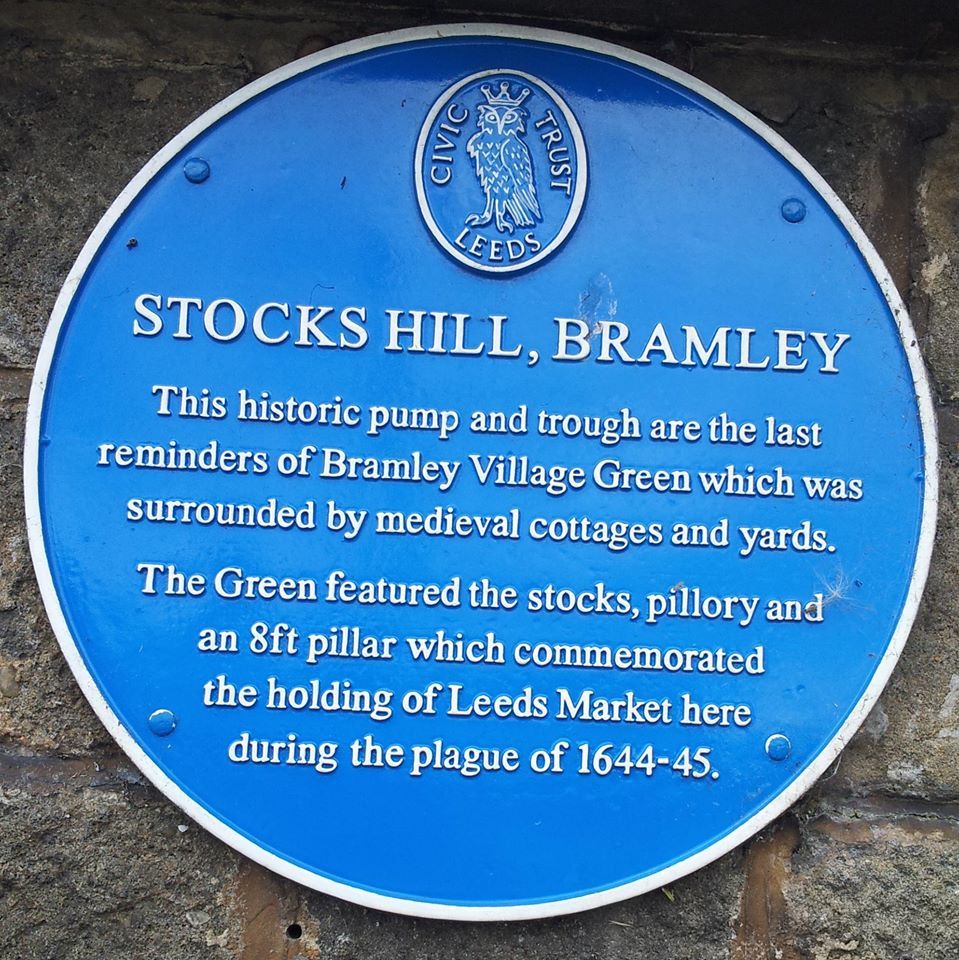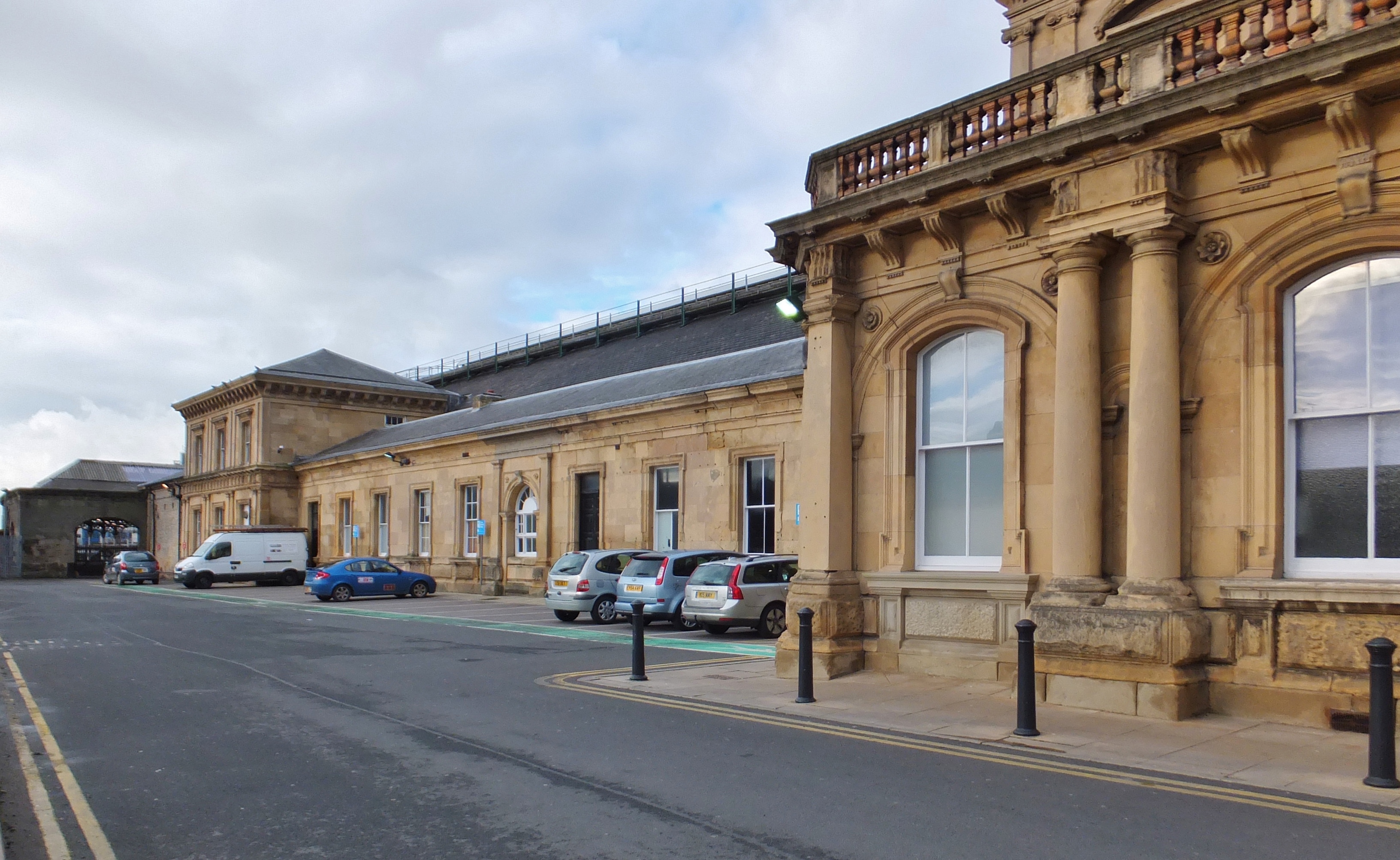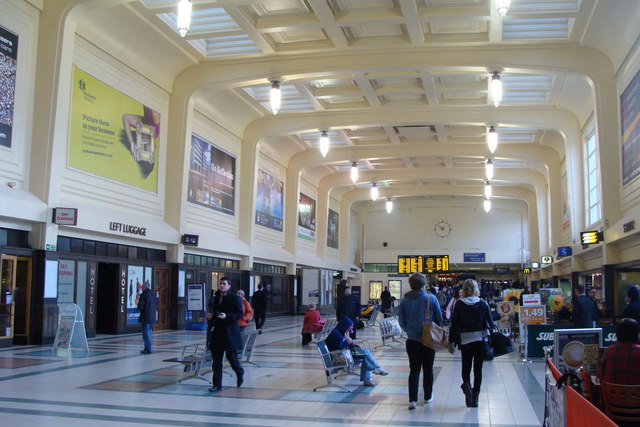|
Bramley (West Yorkshire) Railway Station
Bramley railway station serves the suburb of Bramley, Leeds, England. It lies on the Calder Valley line west from Leeds. History The original station was opened by the Leeds, Bradford and Halifax Junction Railway on 1 August 1854. This was closed by British Railways on 4 July 1966, the last trains having called on 2 July. The station had platforms opposite each other and were connected by a footbridge. The present station off Stanningley Road opened on 12 September 1983 by Metro (West Yorkshire Passenger Transport Executive) and British Rail. The station's two wooden platforms are staggered. Facilities The station is unmanned and has a ticket machine on platform 2 as of spring 2019. There are shelters and passenger information screens on each platform, along with a system to provide train running information. Though there are ramps to each platform, disabled access to platform 2 is restricted by the path being narrow and opening out onto a busy main road. Services Mon ... [...More Info...] [...Related Items...] OR: [Wikipedia] [Google] [Baidu] |
Bramley, West Yorkshire
Bramley is a district in west Leeds, West Yorkshire, England. It is part of the City of Leeds Ward of Bramley and Stanningley with a population of 21,334 at the 2011 Census. The area is an old industrial area with much 19th century architecture and 20th century council housing in the east and private suburban housing in the west. Etymology The name of Bramley is first attested in the 1086 Domesday Book as ''Brameleia'' and ''Bramelei''. The name derives from the Old English words ''brōm'' ('Broom (shrub), broom') and ''lēah'' ('open land in a wood'). Thus the name once meant 'open land characterised by broom'. History At the time of the Domesday survey, the nucleus of the settlement was probably located at Stocks Hill, and it developed in a linear fashion along today's Town Street. The surviving Pump, water pump and stone Watering trough, water trough on Stocks Hill remain from Bramley's medieval past. The accompanying blue plaque states "Stocks Hill, Bramley. T ... [...More Info...] [...Related Items...] OR: [Wikipedia] [Google] [Baidu] |
Hull Paragon Interchange
Hull Paragon Interchange is a transport interchange providing rail, bus and coach services located in the city centre of Kingston upon Hull, England. The G. T. Andrews-designed station was originally named ''Paragon Station'', and together with the adjoining Station Hotel, it opened in 1847 as the new Hull terminus for the growing traffic of the York and North Midland (Y&NMR) leased to the Hull and Selby Railway (H&S). As well as trains to the west, the station was the terminus of the Y&NMR and H&S railway's Hull to Scarborough Line. From the 1860s the station also became the terminus of the Hull and Holderness and Hull and Hornsea railways. At the beginning of the 20th century the North Eastern Railway (NER) expanded the trainshed and station to the designs of William Bell, installing the present five arched span platform roof. In 1962 a modernist office block Paragon House was installed above the station main entrance, replacing a 1900s iron canopy; the offices ... [...More Info...] [...Related Items...] OR: [Wikipedia] [Google] [Baidu] |
Railway Stations In Great Britain Opened In 1983
Rail transport (also known as train transport) is a means of transport that transfers passengers and goods on wheeled vehicles running on rails, which are incorporated in tracks. In contrast to road transport, where the vehicles run on a prepared flat surface, rail vehicles (rolling stock) are directionally guided by the tracks on which they run. Tracks usually consist of steel rails, installed on sleepers (ties) set in ballast, on which the rolling stock, usually fitted with metal wheels, moves. Other variations are also possible, such as "slab track", in which the rails are fastened to a concrete foundation resting on a prepared subsurface. Rolling stock in a rail transport system generally encounters lower frictional resistance than rubber-tyred road vehicles, so passenger and freight cars (carriages and wagons) can be coupled into longer trains. The operation is carried out by a railway company, providing transport between train stations or freight customer faciliti ... [...More Info...] [...Related Items...] OR: [Wikipedia] [Google] [Baidu] |
Railway Stations In Great Britain Closed In 1966
Rail transport (also known as train transport) is a means of transport that transfers passengers and goods on wheeled vehicles running on rails, which are incorporated in tracks. In contrast to road transport, where the vehicles run on a prepared flat surface, rail vehicles (rolling stock) are directionally guided by the tracks on which they run. Tracks usually consist of steel rails, installed on sleepers (ties) set in ballast, on which the rolling stock, usually fitted with metal wheels, moves. Other variations are also possible, such as "slab track", in which the rails are fastened to a concrete foundation resting on a prepared subsurface. Rolling stock in a rail transport system generally encounters lower frictional resistance than rubber-tyred road vehicles, so passenger and freight cars (carriages and wagons) can be coupled into longer trains. The operation is carried out by a railway company, providing transport between train stations or freight customer facilit ... [...More Info...] [...Related Items...] OR: [Wikipedia] [Google] [Baidu] |
Railway Stations In Great Britain Opened In 1854
Rail transport (also known as train transport) is a means of transport that transfers passengers and goods on wheeled vehicles running on rails, which are incorporated in tracks. In contrast to road transport, where the vehicles run on a prepared flat surface, rail vehicles (rolling stock) are directionally guided by the tracks on which they run. Tracks usually consist of steel rails, installed on sleepers (ties) set in ballast, on which the rolling stock, usually fitted with metal wheels, moves. Other variations are also possible, such as "slab track", in which the rails are fastened to a concrete foundation resting on a prepared subsurface. Rolling stock in a rail transport system generally encounters lower frictional resistance than rubber-tyred road vehicles, so passenger and freight cars (carriages and wagons) can be coupled into longer trains. The operation is carried out by a railway company, providing transport between train stations or freight customer facil ... [...More Info...] [...Related Items...] OR: [Wikipedia] [Google] [Baidu] |
Former Great Northern Railway Stations
A former is an object, such as a template, gauge or cutting die, which is used to form something such as a boat's hull. Typically, a former gives shape to a structure that may have complex curvature. A former may become an integral part of the finished structure, as in an aircraft fuselage, or it may be removable, being using in the construction process and then discarded or re-used. Aircraft formers Formers are used in the construction of aircraft fuselage, of which a typical fuselage has a series from the nose to the empennage, typically perpendicular to the longitudinal axis of the aircraft. The primary purpose of formers is to establish the shape of the fuselage and reduce the column length of stringers to prevent instability. Formers are typically attached to longerons, which support the skin of the aircraft. The "former-and-longeron" technique (also called stations and stringers) was adopted from boat construction, and was typical of light aircraft built until the ... [...More Info...] [...Related Items...] OR: [Wikipedia] [Google] [Baidu] |
DfT Category F1 Stations
The Department for Transport (DfT) is a department of His Majesty's Government responsible for the English transport network and a limited number of transport matters in Scotland, Wales and Northern Ireland that have not been devolved. The department is run by the Secretary of State for Transport, currently (since 25 October 2022) Mark Harper. The expenditure, administration and policy of the Department for Transport are scrutinised by the Transport Committee. History The Ministry of Transport was established by the Ministry of Transport Act 1919 which provided for the transfer to the new ministry of powers and duties of any government department in respect of railways, light railways, tramways, canals and inland waterways, roads, bridges and ferries, and vehicles and traffic thereon, harbours, docks and piers. In September 1919, all the powers of the Road Board, the Ministry of Health, and the Board of Trade in respect of transport, were transferred to the new ministry. ... [...More Info...] [...Related Items...] OR: [Wikipedia] [Google] [Baidu] |
Railway Stations In Leeds
Leeds railway station (also known as Leeds City railway station) is the mainline railway station serving the city centre of Leeds in West Yorkshire, England. It is the fourth-busiest railway station in the UK outside London (as of March 2020). It is located on New Station Street to the south of City Square, at the foot of Park Row, behind the landmark Queens Hotel. It is one of 20 stations managed by Network Rail. Leeds is an important hub on the British rail network. The station is the terminus of the Leeds branch of the East Coast Main Line (on which London North Eastern Railway provides high speed inter-city services to every half hour from the station) and is an important stop on the Cross Country Route between Scotland, the Midlands and South West England connecting to major cities such as Birmingham, Glasgow, Edinburgh, Derby, Bristol, Exeter, Plymouth and Penzance. There are also regular inter-city services to major destinations throughout Northern England including Manc ... [...More Info...] [...Related Items...] OR: [Wikipedia] [Google] [Baidu] |
Leeds, Bradford & Halifax Junction Railway
The Leeds, Bradford and Halifax Junction Railway (LB&HJR) was an English railway company. It built a line between Bradford and Leeds, and had running powers over the Lancashire and Yorkshire Railway to Halifax. It opened its main line in 1854 and later built a number of branch lines. It was worked by the Great Northern Railway, giving that company the access it needed to Bradford and Halifax, and the GNR absorbed the LB&HJR in 1865. The line between Leeds and Bradford continues in use at the present day, but the rest of the LB&HJR network has closed. Predecessors In 1840 a through railway connection between Leeds and London was established, over three railways controlled by George Hudson. Hudson was known as the Railway King; he controlled many companies and used underhand methods against his rivals. Later, he was found out and disgraced. The companies around Leeds were the North Midland Railway (from Derby) and the York and North Midland Railway from Normanton on that line ... [...More Info...] [...Related Items...] OR: [Wikipedia] [Google] [Baidu] |
Caldervale Line
The Calder Valley line (also previously known as the Caldervale line) is a railway route in Northern England between the cities of Leeds and Manchester as well as the seaside resort of Blackpool. It is the slower of the two main rail routes between Leeds and Manchester (the other being the Huddersfield line), and the northernmost of the three main trans-Pennine routes. Services Passenger train services are operated by Northern and run on the following pattern: * Bradford Interchange–Halifax– ( Class 150/ 155 trains and occasionally Class 158 * Leeds––Manchester Victoria (Class 150 and 158 trains) * Leeds–Halifax-Manchester Victoria- (Class 158 or Class 195 ''Civity'' trains) * York-Leeds–Halifax–Preston-Blackpool North (Class 158 and 195 trains) * –Burnley––Manchester Victoria (Class 150 or 156) * -Bradford Interchange-Leeds-Hull ( Class 170/ Class 158) This line, along with the Huddersfield line and York and Selby lines, was in the past combined in ... [...More Info...] [...Related Items...] OR: [Wikipedia] [Google] [Baidu] |
Grand Central (train Operating Company)
Grand Central is an open-access train operating company in the United Kingdom. Presently a subsidiary of Arriva UK Trains, it has operated passenger rail services since December 2007. The company was founded in April 2000 as ''Grand Central Railway Company Ltd''. Three years later, the company applied to the Office of Rail Regulation (ORR) to operate a two-hourly open-access service from Newcastle via the Caldervale Line and Manchester Victoria to Bolton, which was rejected. In February 2005, Grand Central successfully applied to operate four daily services from Sunderland to London King's Cross and four daily services from Bradford Interchange to London King's Cross. During December 2007, Grand Central launched its first services on the East Coast Main Line, running between Sunderland and London King's Cross. Following the delivery and refurbishment of additional rolling stock, its full timetable was introduced during March 2008. During March 2008, Grand Central successf ... [...More Info...] [...Related Items...] OR: [Wikipedia] [Google] [Baidu] |








